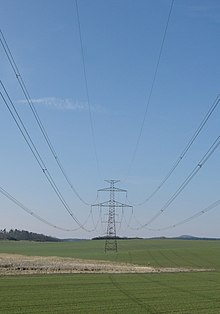
Back Elektriese geleier Afrikaans موصل كهربائي Arabic Conductor llétricu AST Keçirici materiallar Azerbaijani کئچیریجی مادهلر AZB Электрычныя праваднікі Byelorussian Проводник Bulgarian তড়িৎ পরিবাহী Bengali/Bangla Električni provodnik BS Conductor elèctric Catalan

| Articles about |
| Electromagnetism |
|---|
 |
In physics and electrical engineering, a conductor is an object or type of material that allows the flow of charge (electric current) in one or more directions. Materials made of metal are common electrical conductors. The flow of negatively charged electrons generates electric current, positively charged holes, and positive or negative ions in some cases.
In order for current to flow within a closed electrical circuit, one charged particle does not need to travel from the component producing the current (the current source) to those consuming it (the loads). Instead, the charged particle simply needs to nudge its neighbor a finite amount, who will nudge its neighbor, and on and on until a particle is nudged into the consumer, thus powering it. Essentially what is occurring is a long chain of momentum transfer between mobile charge carriers; the Drude model of conduction describes this process more rigorously. This momentum transfer model makes metal an ideal choice for a conductor; metals, characteristically, possess a delocalized sea of electrons which gives the electrons enough mobility to collide and thus affect a momentum transfer.
As discussed above, electrons are the primary mover in metals; however, other devices such as the cationic electrolyte(s) of a battery, or the mobile protons of the proton conductor of a fuel cell rely on positive charge carriers. Insulators are non-conducting materials with few mobile charges that support only insignificant electric currents.